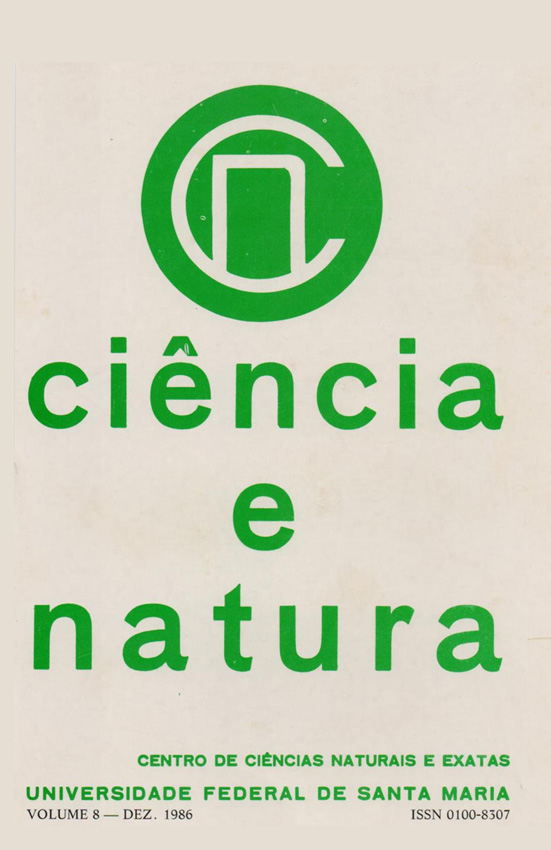Determination of the calibration factors of Albedo Neutron Dosimeter by using the Bonner Spectrometer
DOI:
https://doi.org/10.5902/2179460X25429Abstract
In this work, the calibration factors of Albedo Neutron Dosimeters were determined for several neutron spectra, by simulation of their responses, using a convenient combination of a number of Bonner Spheres, with diferente diameters. The fluence to dose equivalent convertion function, d(E), was also simulated. The satisfactory reproducibility obtained for each dosimeter and the linear behaviour of the total absorbed dose in function of the exposure time, observed for equivalent doses between 10 mRem to 3000 mRem, make the use of albedo Neutron. Dosimeters possible for personal or area routine monitoration.
Downloads
References
Hankins, D.E., Factors Affecting the Design of Albedo Neutron Dosimeters Containing Lithium Fluoride Thermoluminescent Dosimeters, Report LA-4832, Los Alamos Scientific Laboratory (1972).
Piesch, E.,Burgkhordt, B., LiF Albedo Dosimeters for Personnel Monitoring in a Fast-Neutron Radiation Field, Proc. Symp., IAEA, Vienna (1973).
Preston, H. E., Peabody, C.O., Measurements of Personnel Neutron Dose in Reactor and Associated Aras. Proc. Symp., IAEA, Vienna ( 1973) .
Harvey, J.R., Hudd, W.H.R. and Towsend, S., A Personal Dosimeter wich Measures Doses from Thermal and Intermediate Energy Neutrons and from Gama and Beta Radiation, Berkeley Nuclear Laboratory, Report RD/B/N-1547, Berkeley, England (1969).
Brown, J.B.C., Gayton, F.M., Hall, J.A., Harvey, J.R. and Weeb, G.A.M., Recomendations Concerning the Use of the Personnel Neutron Albedo Dosimeter, Berkeley Nuclear Laboratory, Report RD/B/R-828, Berkeley, England (1967)
Alsmiller Jr., R.G., Barish, J., The Calculated Response of LiF Albedo Dosimeters to Neutron with Energies <400 MeV, Health Physics, 26, (1974).
Hoy, J.E., Personnel Albedo Neutron Dosimeter with Thermolumines cent 6LiF and 7LiF Report DP-1277, E.I. du Pont de Nemous, Savannah River Plant (1972).
Harvey, J.R., Beynon, S., A Neglected Energy Range, Proc. Symp. on Neut. Dosim. in Biol. and Med., Neuherberg, Munich (1972).
Seguin, H., Resultats Preliminaires d'un Programme de Comparaison des Dosimetres Individuels a Neutrons, Proc. Symp. on Neut. Monit. for Rad. Prot. Purposes, IAEA, Vienna (1 973).
Becker, K., Solid State Dosimetry, CRC Press, Cleveland, Ohio (1973)
Nachtigall, D., Contribution of Intermediate Energy Neutrons to the Neutron Dose-Equivalent Outside the Shielding of Reactors and High Energy Accelerators, Proc. Symp. on Neut. Monit., IAEA, Vienna (1967).
Hankins, D.E., Monitoring Intermediate Energy Neutrons, Health Physics,9, (1963).
Regulatory Guide 8.14, Office of Standards Development, U.S. Nuclear Regulatory Commission, (1976).
Furuta, Y., Tanaka, S., Response of 6LiF and 7LiF Thermoluminescence Dosimeters to Fast Neutrons, Nucl. Inst. Meth., 104, (1972) .
Carvalho, W.B.D., Monitor Pessoal de Neutrons Baseado na Técnica de Albedo, Tese de Mestrado, IME, Rio de Janeiro (1975).
Nachtigall, D., Burger, G., Dose Equivalent Determinations in Neutron Fields by Means of Moderator Techniques, Topics in Radiation Dosimetry, Academic Press (1972).
Bramblet, R.L., Ewing, R.I. and Bonner, T.W., A New Type of Neutron Spectrometer, Nucl. Inst. Meth.,9, (1960).
Awschalom, M., Use of Multisphere Neutron Detector for Dosimetry of Mixed Radiation Fields, Proc. Symp. on Neut. Monit., IAEA, Vienna (1967).
Reinert de Lima, C.A., PAJMQ - Programa para Ajustamento Automático por Mínimos Quadrados, IME.
SCHUCH, L.A., Calibração de Monitores de Neutrons com Moderadores e Aplicação na Determinação de Fatores de Calibração de Dosimetros de Albedo. Tese de Mestrado, IME, Rio de Janeiro (1979) .
Californium-252, Guide for Fabricating and Handling 252Cf Sources ,SRO 153, (1971).
Fields, P.R., Diamond, H., Californium - 252, A Primary Standard for Neutrons, Proc. Symp. on Neut. Dosim. in Biol. and Med.,IAEA (1962).
Downloads
Published
How to Cite
Issue
Section
License
To access the DECLARATION AND TRANSFER OF COPYRIGHT AUTHOR’S DECLARATION AND COPYRIGHT LICENSE click here.
Ethical Guidelines for Journal Publication
The Ciência e Natura journal is committed to ensuring ethics in publication and quality of articles.
Conformance to standards of ethical behavior is therefore expected of all parties involved: Authors, Editors, Reviewers, and the Publisher.
In particular,
Authors: Authors should present an objective discussion of the significance of research work as well as sufficient detail and references to permit others to replicate the experiments. Fraudulent or knowingly inaccurate statements constitute unethical behavior and are unacceptable. Review Articles should also be objective, comprehensive, and accurate accounts of the state of the art. The Authors should ensure that their work is entirely original works, and if the work and/or words of others have been used, this has been appropriately acknowledged. Plagiarism in all its forms constitutes unethical publishing behavior and is unacceptable. Submitting the same manuscript to more than one journal concurrently constitutes unethical publishing behavior and is unacceptable. Authors should not submit articles describing essentially the same research to more than one journal. The corresponding Author should ensure that there is a full consensus of all Co-authors in approving the final version of the paper and its submission for publication.
Editors: Editors should evaluate manuscripts exclusively on the basis of their academic merit. An Editor must not use unpublished information in the editor's own research without the express written consent of the Author. Editors should take reasonable responsive measures when ethical complaints have been presented concerning a submitted manuscript or published paper.
Reviewers: Any manuscripts received for review must be treated as confidential documents. Privileged information or ideas obtained through peer review must be kept confidential and not used for personal advantage. Reviewers should be conducted objectively, and observations should be formulated clearly with supporting arguments, so that Authors can use them for improving the paper. Any selected Reviewer who feels unqualified to review the research reported in a manuscript or knows that its prompt review will be impossible should notify the Editor and excuse himself from the review process. Reviewers should not consider manuscripts in which they have conflicts of interest resulting from competitive, collaborative, or other relationships or connections with any of the authors, companies, or institutions connected to the papers.






